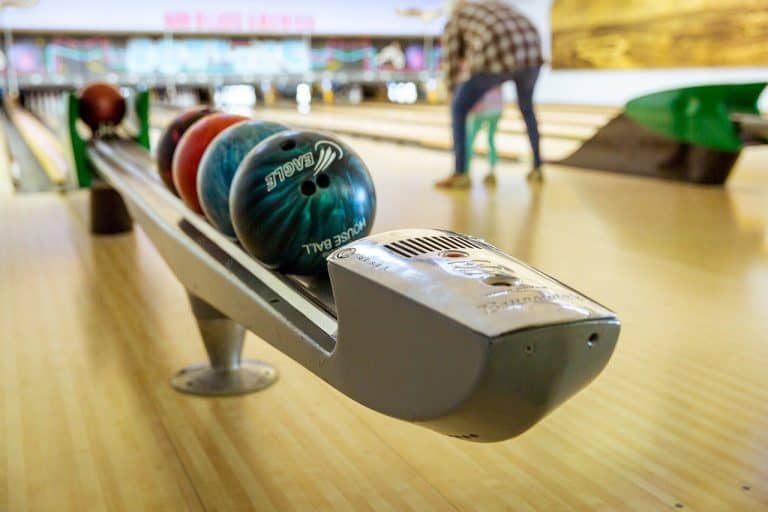Ever Wonder Why Bowling Pins Have Red Stripes?
Whether you are a recreational or pro bowler, you may have noticed that bowling pins have two red stripes painted around the neck. However, this was not always the case. So why do today’s bowling pins have red stripes?
Bowling pins have red stripes for purely cosmetic reasons. When bowling pins started being coated and painted, multiple manufacturers adopted the design. Today, striped pins have become the norm in the sport. Stripes do add color contrast, which helps the eyes and brain process depth perception.
Read on to learn more about bowling pins. We will be covering how they are made, including the origin of their signature red stripes. They have even become recognized by The United States Bowling Congress.
Why Do Bowling Pins Have Red Stripes?
The anatomy of a bowling pin takes inspiration from the human form. Not sure what we mean? Just take a look below:
As the picture illustrates above, a bowling pin has a crown, head, neck, and body. The two stripes we commonly see are placed around the neck. This may be why Al Vanderneck of the United States Bowling Congress stated that they “just look funny” without them. After adorning bowling pins for over fifty years, the detail aesthetically makes sense, like a tie on someone wearing a tuxedo.
Still, the birth of the red stripes is shrouded in mystery. A common myth is that the stripes originated from AMF (American Machine and Foundry). Brunswick used a crown around the neck as a brand trademark for years, and many assumed AMF used the stripes in a similar way.
However, this theory was disproved by the AMF product manager, Ron Pominville. The red stripes are currently utilized by many major manufacturers, including AMF, Brunswick, and Vulcan.
What we do know is that the modern bowling pin is a fairly recent invention. The sport itself has been around for hundreds of years, dating back to 300 AD (source.)
In fact, bowling started as a religious ceremony by German monks, who used the pins to symbolize sins that would be struck down by the bowling ball. It was not until Joe Thum founded the American Bowling Congress (now the USBC) in 1895 that a movement to standardize pins for the sport began.
The modern bowling pin has been developed over the past centuries to meet the sport’s specific needs—durability, scoring, and sound. A high-quality pin needs to be able to withstand being knocked down by the ball. However, the only way to score is to strike down a pin, so they cannot be so heavy that they will not fall down. Lastly, when bowling pins fall, they make a sound that clearly indicates they have been knocked down.
A lot of changes had to be made to meet these requirements. At first, bowling pins were made from one single block of maple. However, using maple from the same block would cause the pins to splinter at the layers. However, Vulcan’s model, developed in 1954, solved this problem by gluing multiple maple pieces together around a core.
Pin coating faced a similar obstacle. Originally, pins were coated with one layer of white lacquer and one layer of clear lacquer. However, as mechanical pinsetters became more common, the lacquer coatings proved too weak to hold up. Eventually, a seven-layer coating process utilizing ethylcellulose helped remedy the issue. Now, the most common materials used for coating are nylon and DuPont’s Surlyn.
Any decorative markings, including brand emblems, USBC approval stamps, and details like the signature red stripes, are silk-screened onto the pin after coating. These pin advancements, like cores, coatings, and silk screenings, occurred in the mid-50s to early 60s. This would explain why the stripes became associated with companies like AMF, which became a huge staple in the sport.
In sum, the design choice originated about sixty years ago and has remained popular ever since. At this point, bowling pins would simply be “naked” without their stripes.
Are There Bowling Pins Made Without Red Stripes?
While traditional bowling pins employ the famous red stripes, there are plenty of exceptions. Trophy Pins, for example, are designed to commemorate special occasions, such as remembering a high score or tournament event.
Bowling pins are also made in various colors. Brunswick’s Color Max Pins come in magenta, green, yellow, and orange. Even websites sell customized bowling pins with designs for all tastes.
Bowling alleys also use specialty pins for promotional purposes. Often, specialty pins are placed in ten pin sets as an incentive for players. When a bowler strikes down the specialty pin and reports it to a manager, they can receive a special prize.
How to Use the Red Stripes to Your Advantage
Considering the placement of the stripes on the pin’s neck, they can be used to help your technique. In a sea of white, the red stripes help set each pin apart, which will be important for your accuracy.
Bowling pins are set in a triangle about 12 in (30.5 cm) away from each other. There are ten pins altogether, arranged in four rows. Pin 1 is in the front row. Behind Pin 1 is the second row, which contains Pins 2 and 3. Pins 4, 5, and 6 make up the third row, and Pins 7 through 10 make up the fourth row behind it. All pins are counted from the front to the back row, left to right.
It may seem trivial to new bowlers, but learning the pin numbers can seriously up your game. It will help you understand certain splits, such as the infamous 7-10 split. Additionally, you will better understand what pins to aim for, what pins you have knocked down, and what pins are left standing.
Just take a look at this picture below.
The path to a strike is like knocking down a stack of dominos. If the ball hits the pins correctly, one will knock down another until they all fall down. However, where is the best place to aim for? That is what is known as the ‘pocket.’
The ‘pocket’ is the best place for a bowler to aim in order to score a strike. If you are left-handed, it is best to aim between Pins 1 and 2. Conversely, right-handers should aim between Pins 1 and 3.
Rather than aim straight for the middle, aiming slightly to the center’s left or right is the best way to make the domino effect that will ensure a strike. Since you aim between two pins rather than making a direct hit, that is why it is called the ‘pocket.’
If you find yourself lost looking for the pocket, the red stripes can serve as a guide. If you’ve ever gone bowling before, even though the pins are a foot (.3 m) apart, they look much closer together. Additionally, pins are wider at the bottom, making them harder to visually separate.
However, the stripes are located much higher at the neck, which is the pin’s narrowest part. So, in theory, you could navigate the red stripes of the pins to locate the pocket.
Final Thoughts
In short, the red stripes on bowling pins originated back in the 50s and 60s as bowling became more popular as a sport. While the first company to use the design is unknown, the red stripes became a common choice among pin manufacturers.
However, there are exceptions, including trophy pins, promotional pins, specialty pins, and even customizable pins. Learning about bowling pins is essential for all new bowlers and will improve your technique.







